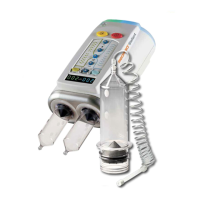
Do you have a question about the Bayer HealthCare MEDRAD Stellant and is the answer not in the manual?
| Device Type | Contrast Injection System |
|---|---|
| Application | Radiology |
| Manufacturer | Bayer HealthCare |
| Model | Stellant |
| Number of Syringes | Dual |
| Flow Rate | 0.1 to 10 ml/sec |
| Pressure Limit | 325 psi |
| Programmable Phases | Yes |
| Power Requirements | 100-240 V AC, 50/60 Hz |
| Display | Touchscreen |
| Syringe Capacity | 200 mL (per syringe) |
| Syringe Size | 200 mL |
| Connectivity | Ethernet |
| Compatibility | Compatible with various CT scanners |
Details the certifications and standards the device complies with, including EMC requirements.
Specifies the intended patient group and the medical applications for the injection system.
Lists conditions where the device should not be used and legal restrictions on its sale.
Specifies necessary training and provides disclaimers regarding modifications and external equipment.
Explains the function of the Equipotential Connector and provides installation information.
Explains various safety, warning, and informational symbols used throughout the manual.
Details the various buttons and icons found on the injector head interface.
Explains the buttons and icons visible on the system's display screen.
Describes icons associated with the base unit and the overhead IV track system.
Lists critical safety warnings to prevent serious patient or worker injury or death.
Provides important cautions to prevent minor injuries and notices regarding equipment damage.
Illustrates the main components of the injection system and their connections.
Explains fluid delivery basics, protocols, pressure limiting, and protocol manager functions.
Highlights features designed to simplify syringe loading and setup.
Explains Programming Mode for settings and mentions informatics platform integration.
Provides instructions for using the system's pedestal and IV pole.
Details the main interface elements of the system's home screen, including indicators and controls.
Describes workstation models and explains their front view buttons and icons.
Describes the buttons and icons specific to the workstation model equipped with a pod.
Details the controls and components of the injector head, including heat maintainer and manual knob.
Explains the functionality and indicators of the handswitch for starting and stopping injections.
Provides step-by-step instructions for powering on the injection system.
Explains normal and hard shutdown procedures and options for the system.
Describes how to restore the system after an injector shutdown.
Guides users on creating new or modifying existing injection protocols and phase types.
Explains the process of saving created or edited protocols and retrieving them.
Introduces the DualFlow feature for simultaneous contrast and saline delivery and its programming.
Outlines necessary steps for preparing the system in the control room, including protocol selection.
Lists essential preparations for the scan room, including fluid detection and tubing setup.
Explains volume indicators and the process of arming the injector from control or scan rooms.
Details starting injections, operator-initiated holds, aborting, and viewing progress.
Details the screen and actions upon completing an injection, including summary and next steps.
Explains the information displayed when an injection is aborted and how to exit the screen.
Guides on configuring system-wide settings like language, units, and reminders.
Details the setup for the P3T software, which is separately licensed.
Instructions for managing, organizing, deleting, and renaming protocols and regions.
Details configuration options for fluid delivery and refers to informatics setup instructions.
Instructions for accessing the help system and selecting fluid values.
Explains how injector head LEDs indicate errors and how to recover from them.
Describes the error screen, its messages, and procedures for error recovery.
Explains the different types of tones the system can emit, general and notification tones.
Procedures for cleaning up spills and daily cleaning of the injector head.
Daily inspection, cleaning, and disinfection of the injector head and other system parts.
Monthly operational checkout and annual maintenance like calibration and leakage checks.
Provides instructions for moving and reinstalling the system in a different room.
Lists available mounting hardware and extension cables for the injector head and workstation.
Lists various compatible accessories, manuals, and sterile disposable items for the system.
Details specifications for workstation and workstation with pod, including dimensions, connections, and power.
Details specifications for the base unit and injector head, including dimensions and weight.
Covers environmental conditions, protection against electrical shock, EMI/RFI, and fluid ingress.
Details fluid delivery performance, flow rates, and infusion protection features.
Details power cable requirements, cybersecurity controls, network connections, and fuse specifications.